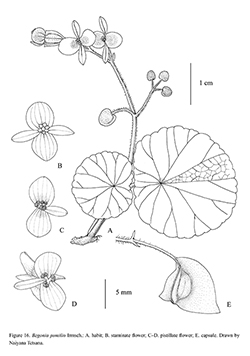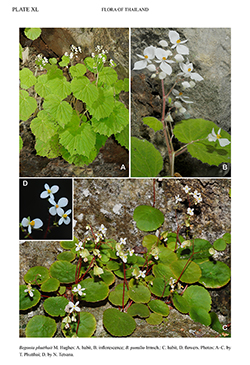e-Flora of Thailand
Volume 14 > Part 3 > Year 2019 > Page 412 > Begoniaceae > Begonia
41. Begonia pumilio Irmsch.wfo-0000825245
[§ Reichenheimia], Mitt. Inst. Allg. Bot. Hamburg 8: 102. 1929; Hughes, Annot. Checkl. SE Asian Begonia. 104. 2008. Fig. 18. Plate XL: C–D.
Accepted Name : This is currently accepted.
Synonyms & Citations :
Description : Monoecious caulescent herb, 10–15 cm tall. Stems erect, terete, dark red, tuber globose or subglobose with numerous fibrous roots, ca 10 mm diam. Leaves 1–2 per plant; petiole dark red, 2−5 cm long; lamina dorsifixed, membranaceous, symmetric, chartaceous when dry, glabrous on both sides, adaxial surface dull dark green or light bright green, abaxial surface pale green, peltate, 3 by 7 cm, base rounded, apex rounded, margin crenate or undulate, venation palmate, veins 7−8, prominent beneath. Stipules caducous, narrowlylanceolate, ca 2 mm long. Inflorescences terminal, paniculate, bisexual, 8−15 cm long, staminate flowers basal, pistillate flowers distal, protandrous; peduncles dark red, ca 6−8 cm long, terete, densely glandular hairy. Bracts persistent, lanceolate, ca 2 by 1 mm; bracteoles 1 pair, opposite, lanceolate, ca 2 mm long. Staminate flowers: pedicels ca 10 mm, densely glandular hairy; tepals 4, white, outer 2 ovate, 5 by 4 mm, base obtuse, apex obtuse, margin entire, outer parts pilose, inner parts glabrous, inner 2 linear oblanceolate, ca 3 by 1 mm, base obtuse, apex obtuse, margin entire, glabrous on both sides; androecium actinomorphic, elliptic, stamens 8−10, filaments fused at base, ca 0.5 mm long, anthers oblong, ca 1 mm long, thecae wing-like, dehiscing by longitudinal slits. Pistillate flowers: pedicels, pale green, ca 10 mm long, densely glandular hairy; tepals 3, plain white, outer 2 ovate, ca 5 by 4 mm, glabrous on both sides, inner 1 oblanceolate, ca 3 by 1 mm, glabrous on both sides; styles 3, fused at base, stigmatic band crescent-shaped; ovary with 3 unequal wings, 3-locular, placentae unilamellate. Fruit a dehiscent capsule, drying pale brown, 8−10 by 10−13 mm with wings; locules ovate, 4−5 by 4−5 mm, abaxial triangular, ca 10 mm long, 2 lateral wings narrowly triangular, 4 mm curved along length of capsule. Seeds brown, barrel-shaped.
Thailand : PENINSULAR: Phangnga (Pulau Panji – type: Haniff & Nur SFN4076, syntypes -K), Nakhon Si Thammarat.
Distribution : Endemic.
Ecology : On damp karst limestone cliffs, near sea level. Flowering: July–September; fruiting: September–December.
Vernacular : Dat bai bua (ดาดใบบัว).
Notes: Craib (1931) described Begonia sibthorpioides Ridl. var. grandifolia Craib from the same locality as B. pumilio Irmsch. There is no doubt that both names belong to the same taxon. Further exploration along the karst range in Phangnga province into northern Peninsular Malaysia could potentially reveal further records.


